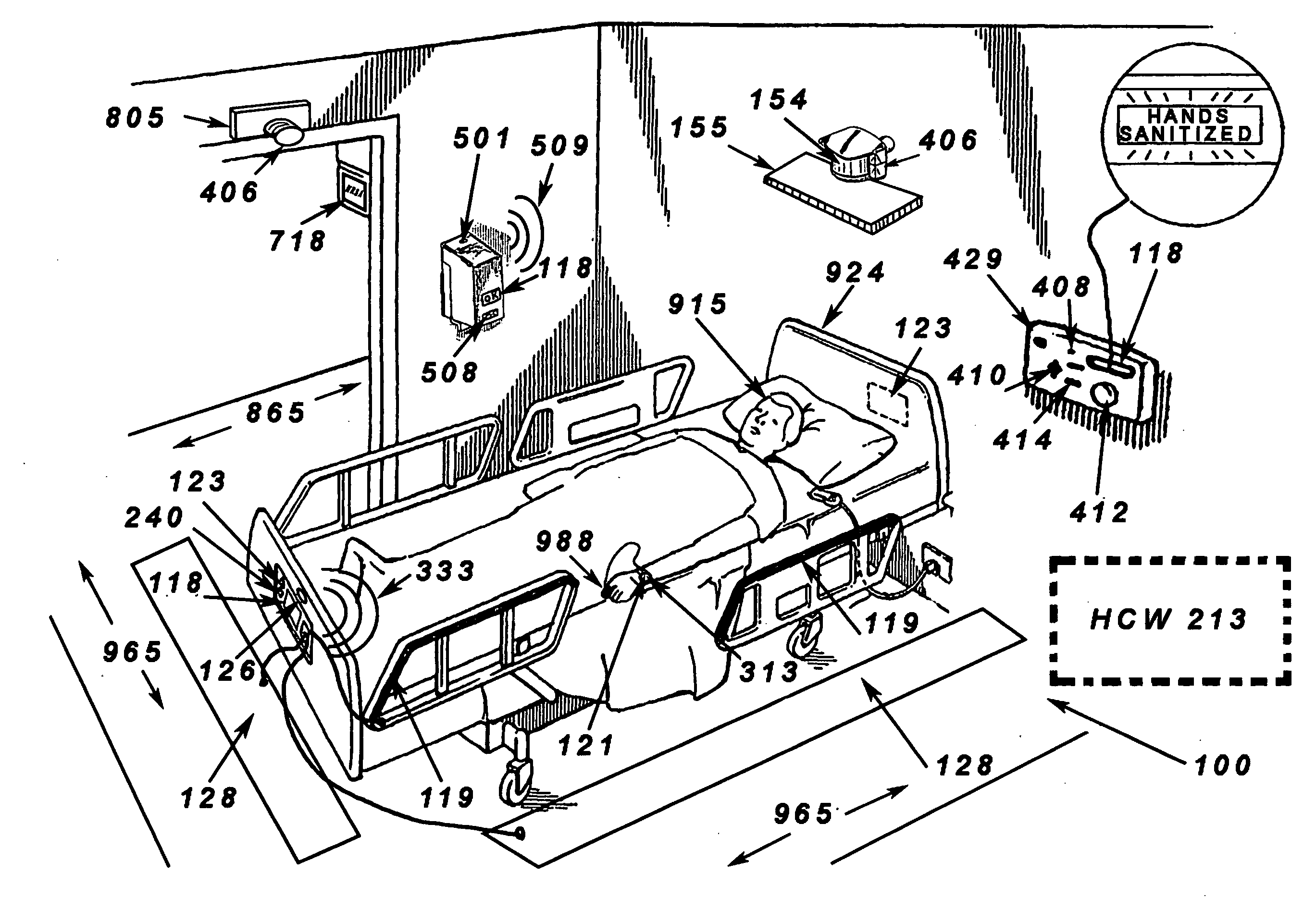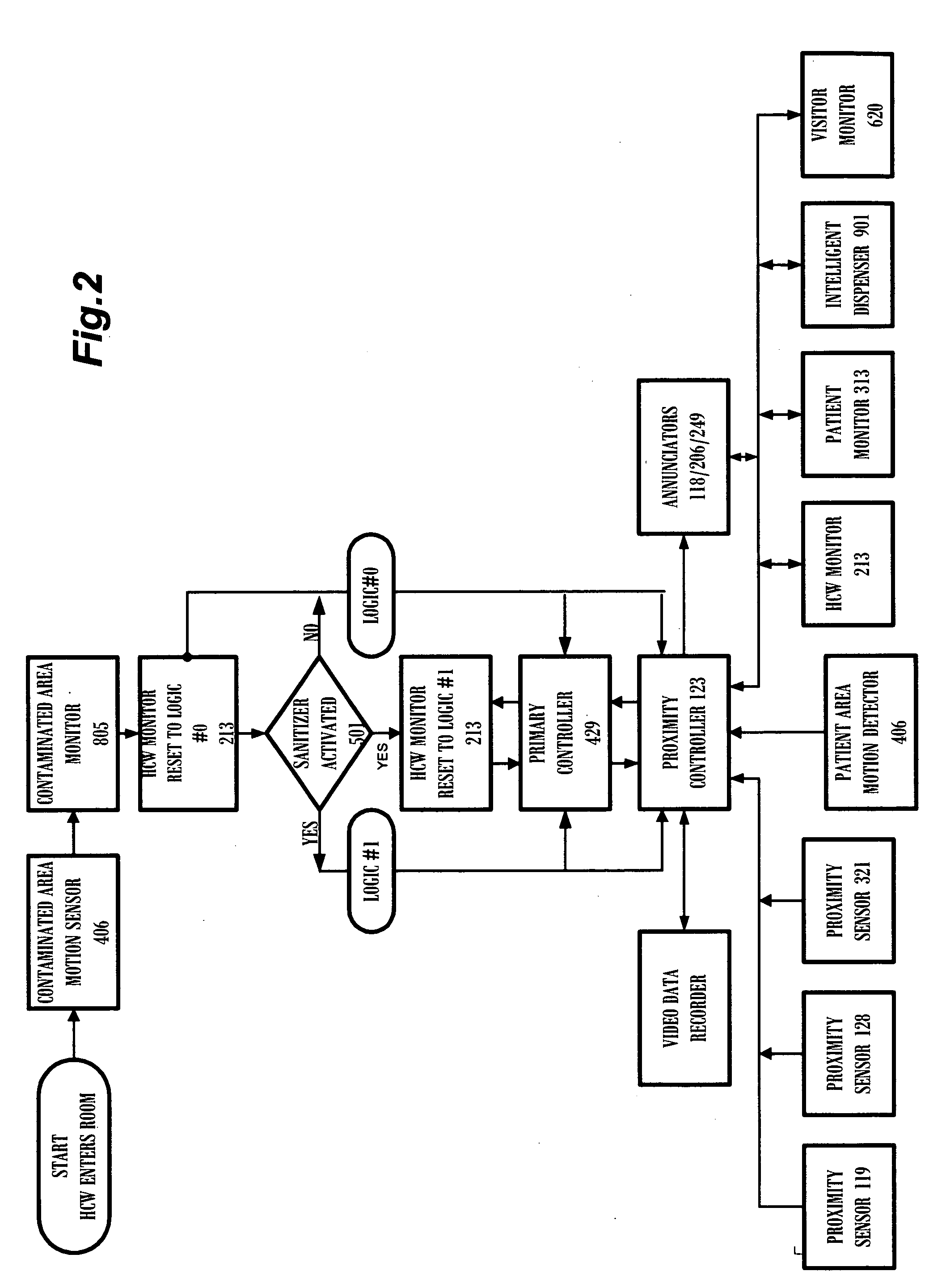Systems and methods for monitoring health care workers and patients
a health care worker and system technology, applied in the field of systems and methods for monitoring health care workers, can solve the problems of limited effectiveness of signs reminding people to sanitize their hands, and the tendency of hygienic warnings for such persons to be ignored
- Summary
- Abstract
- Description
- Claims
- Application Information
AI Technical Summary
Benefits of technology
Problems solved by technology
Method used
Image
Examples
example 1
[0058]In a first situation, a health care worker wearing a monitor 213 enters a room and is detected by the motion sensor 406 associated with the controller 805. In this example, the room is considered a contaminated area 865. The worker will be considered “contaminated” when he enters (or leaves) the contaminated area and the controller 805 accordingly generates a low power signal to the monitor 213 (or sanitizer 901 if a portable sanitizer is used instead of a monitor 213). This signal causes the monitor to set to Logic #0. (It will be appreciated that the monitor will be already have been set to Logic #0 if the worker has previously been detected in any contaminated area without washing his hands or if too much time has elapsed since the previous hand washing.) The worker may proceed to perform duties within the room that are not in close proximity to the patient without receiving a warning or causing a violation to be noted though he has not washed his hands. Even if detected by...
example 2
[0059]In a second situation, a health care worker enters a patient's room and then uses the hand sanitizer 501 in accordance with required hygienic protocol. The sanitizer generates a signal 509 that causes the worker's monitor to reset to Logic #1 from Logic #0 and the monitor display 118 to show a message indicating hand washing compliance. The health care worker then proceeds to the patient care area 965, first being detected by the patient care area motion detector 406 associated with the proximity controller 123 and then by one or more of the proximity sensors 128, 119, 321. The monitor 213 is queried by the proximity controller 123, which generates a signal 133 upon sequential actuation of the motion detector 406 and one of the proximity sensors. An encoded signal 239 indicating compliance with hand washing protocol is returned by the monitor 213. The display 118 associated with the proximity controller 123 is caused to generate a message such as “Sanitized.” Activation of the...
example 3
[0060]In a third situation, a health care worker enters a patient care area 965 and a hand washing reminder message is displayed by the primary controller following detection by the patient care area motion detector 406. The worker, in this case, has washed his hands using the sanitizer 501 associated with the patient and / or room, but has allowed too much time to elapse since such washing. The display 206 on the monitor 213 is accordingly caused to illuminate or flash to signify that excessive time has elapsed, and the monitor status changes from Logic #1 to Logic #0. The worker then proceeds to near proximity of the patient, i.e. within arms length of the patient or bed, and is detected by one of the proximity sensors 128. This causes the proximity controller 123 to transmit an encoded signal 133 requesting a response signal from the monitor 213. The monitor 213 then transmits an encoded signal reflecting the Logic #0 status of the monitor. Upon receipt of this signal by the proxim...
PUM
 Login to View More
Login to View More Abstract
Description
Claims
Application Information
 Login to View More
Login to View More - R&D
- Intellectual Property
- Life Sciences
- Materials
- Tech Scout
- Unparalleled Data Quality
- Higher Quality Content
- 60% Fewer Hallucinations
Browse by: Latest US Patents, China's latest patents, Technical Efficacy Thesaurus, Application Domain, Technology Topic, Popular Technical Reports.
© 2025 PatSnap. All rights reserved.Legal|Privacy policy|Modern Slavery Act Transparency Statement|Sitemap|About US| Contact US: help@patsnap.com



